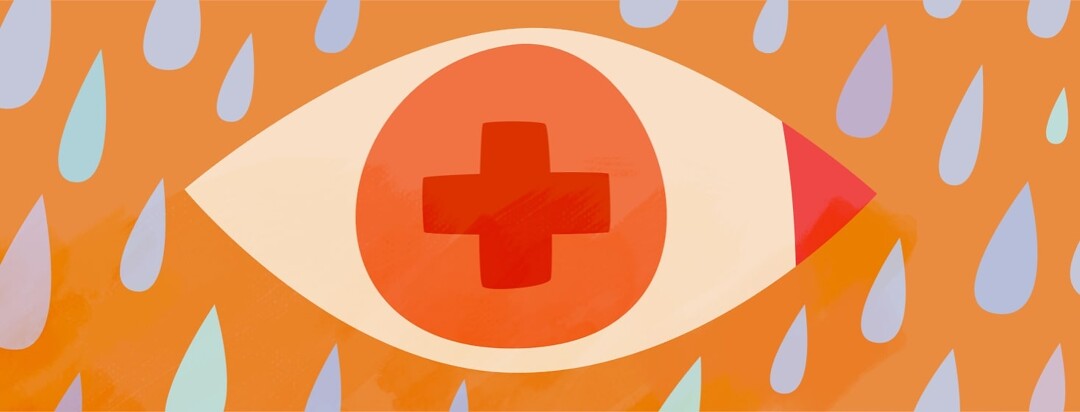Eye Irritation: My Journey With Iritis
Have you ever felt like you had a piece of dirt stuck in your eye, and no matter how many times you rinsed it, or how many drops you used, it just wouldn't come out?
Have you ever been driving at night and all of a sudden had a car driving towards you with their high beams on?
Have you ever accidentally been poked in the eye, and dealt with the lingering pain and discomfort (plus some pretty intense redness)?
My iritis (uveitis) experience
My experiences with iritis have been the worst combination of all of the above. The first time, I was CONVINCED that I had a scratch or a tear in my cornea, and I remember calling 5 different eye doctors to find the earliest appointment because I was in so much discomfort - in retrospect, this was actually the mildest case of iritis I’ve ever had.
I managed to make an appointment with an eye doctor that day and he explained that there wasn’t a scratch or tear, but that I was actually experiencing inflammation within my eye. He put me on steroid eye drops and told me it was probably no big deal as long as it didn’t happen again.
My second flare led to my ankylosing spondylitis diagnosis
My second iritis flare, the one that eventually led to my AS diagnosis, was when I really experienced the whole range of symptoms. It started with the familiar sensation that there was something in my eye that I just couldn't seem to flush out. I made an appointment with my eye doctor who put me on the same steroid eye drops as before, but also put in a referral with an ophthalmologist just to "have everything checked out."
Unfortunately, the round of steroid drops was not effective this time around, and my symptoms continued to get worse. The gritty feeling persisted, my eye started to ache and throb, and I was increasingly sensitive to light. My phone was always on the dimmest setting, and watching TV was uncomfortable unless I covered the "bad eye." I pretty quickly realized that things weren't improving and that I couldn't wait a few more weeks for my appointment with the ophthalmologist.
I called and was prescribed more/stronger prescription eye drops to start while I waited to see the specialist. Round two of steroid drops didn't yield much improvement.
I ended up seeing a top eye researcher
Through sheer luck of living in the right place and getting a good referral, it turns out I was seeing one of the nation's top ophthalmologic researchers in iritis and uveitis. That visit turned out to be the true turning point for not only my eyes but my entire medical journey.
The new ophthalmologist put me on not only another round of steroid eye drops, but scar tissue was starting to build up, so I now had to also use a dilating eye drop multiple times a day to keep my pupil open and give everything time to heal.
Do you know the feeling when you leave the eye doctor's from a normal dilation appointment, and your vision is all weird for a few hours? That was my normal for 2 weeks in the affected eye - dizzying blurry vision and one super dilated pupil.
The iritis was finally under control and starting to feel better, and the ophthalmologist was running blood work to figure out why this was happening to me- blood work that eventually led to the discovery that I am HLA-B27 positive, which eventually led to my current diagnosis.
Iritis goes hand in hand with AS
I later learned that iritis is a fairly common complication of ankylosing spondylitis, and even on my current biologic (which was a recommendation of my ophthalmologist) I have still had two iritis flares in the past few years. Thankfully, I now go straight to my ophthalmologist when I feel the symptoms setting in and she gets me started on steroid drops before the inflammation ever has a chance to get as severe as it once did.
My most recent flare led to a discussion about medications - a concern that I could be facing permanent eye damage if I continue to get iritis flares, and it doesn't seem like my current biologic medication is helping prevent it as much as it once did. We decided to stick with my current treatment course for now, but having to consider a full medication switch because of my eyes (even when all other AS symptoms are mostly in check) is pretty frustrating.
Ankylosing spondylitis presents itself in different ways at different times, and learning the signs and symptoms of each is an important part of my treatment plan. Some AS patients will never deal with inflammation in their eyes, and some will deal with it even more frequently than I do. For now, I’m just crossing my fingers that my symptoms stay in check, and am continuing to tackle every aspect of my disease day by day.

Join the conversation